January 2, 2018

Bison production is one segment of the agriculture industry that had a record year of profitability and stability in 2017.
Dave Carter, executive director of the National Bison Association, says bison producers are mapping out plans for continued growth in 2018 by expanding efforts to connect with consumers and bringing new producers into the fold.
"Six months ago, the National Bison Association and partners in the InterTribal Buffalo Council and the conservation community announced an ambitious goal to restore 1 million bison to North America, effectively more than doubling the size of today's herds," Carter says. "For bison ranchers, that means we must continue to introduce deliciously healthy bison to more people, and we must expand our production from coast to coast."
The bison business is riding a sustained wave of profitability as sales of the meat continued to grow. According to USDA, the prices marketers paid for dressed bison bulls averaged higher than $4.80 per pound throughout 2017. Dressed prices refer to the amount paid to ranchers once the animal is harvested.
"We anticipate that prices will remain strong as demand for bison meat continues to grow," Carter says.
There are a number of advantages for bison producers. The animals are naturally hardy, having evolved in tandem with the grasses native to the North American ecosystem, and they thrive in a wide variety of climates.
While bison are similar in some ways to cattle, there are significant differences. For example, bison will turn into a snowstorm rather than drifting with the wind because they instinctively know that walking into the storm will get them out of the weather quicker.
Bison calve more easily than cattle, largely on their own with no human assistance. They also have long productive lives with some cows delivering healthy calves for as long as 30 years.
It is important for producers to be aware that an important difference between bison and other livestock: they are not a domesticated animal. They require special consideration when handling.
Seasoned producers know that the animals respond best in low-pressure, low stress conditions. These producers have developed special handling systems, corrals and techniques to ensure the safety for the animal and themselves.
Carter says that the National Bison Association is planning several programs to reach out to new producers in 2017. The association's winter conference and live bison show and sale at the National Western Stock Show in Denver Jan. 17-20 to provide an opportunity for prospective producers to investigate the business.
"More than 400 ranchers will gather for the winter conference to discuss issues and share information," Carter says. "And the association's Gold Trophy Bison Show at the National Western Stock Show has the largest number of entries in nearly 20 years, so there's plenty of opportunity for people to purchase great animals to build, or to start, their herds."
Information on all things bison is at bisoncentral.com.
Source: National Bison Association
You May Also Like




